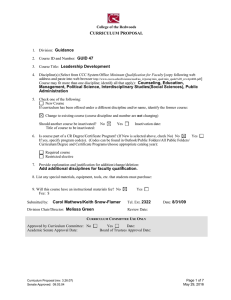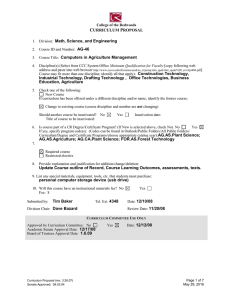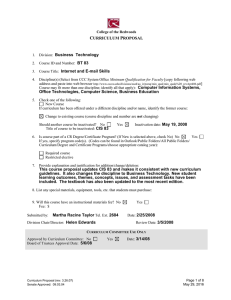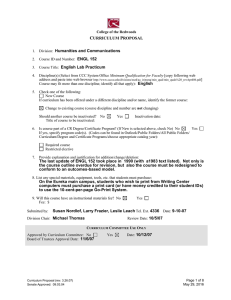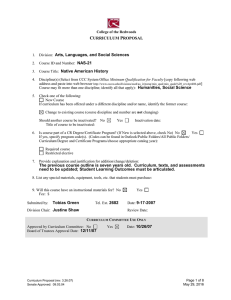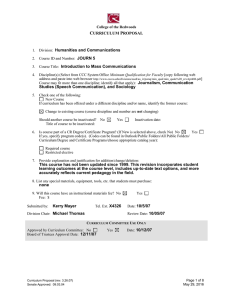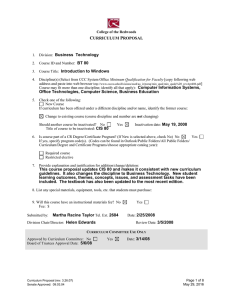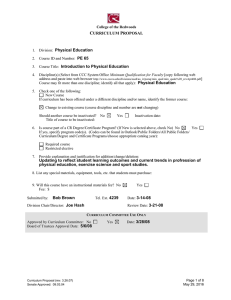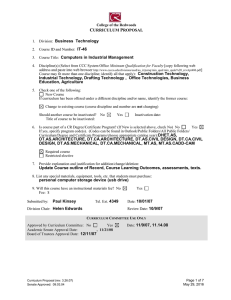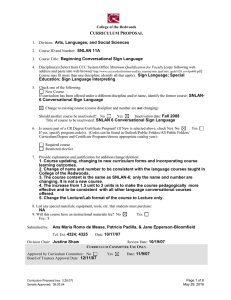C P URRICULUM
advertisement
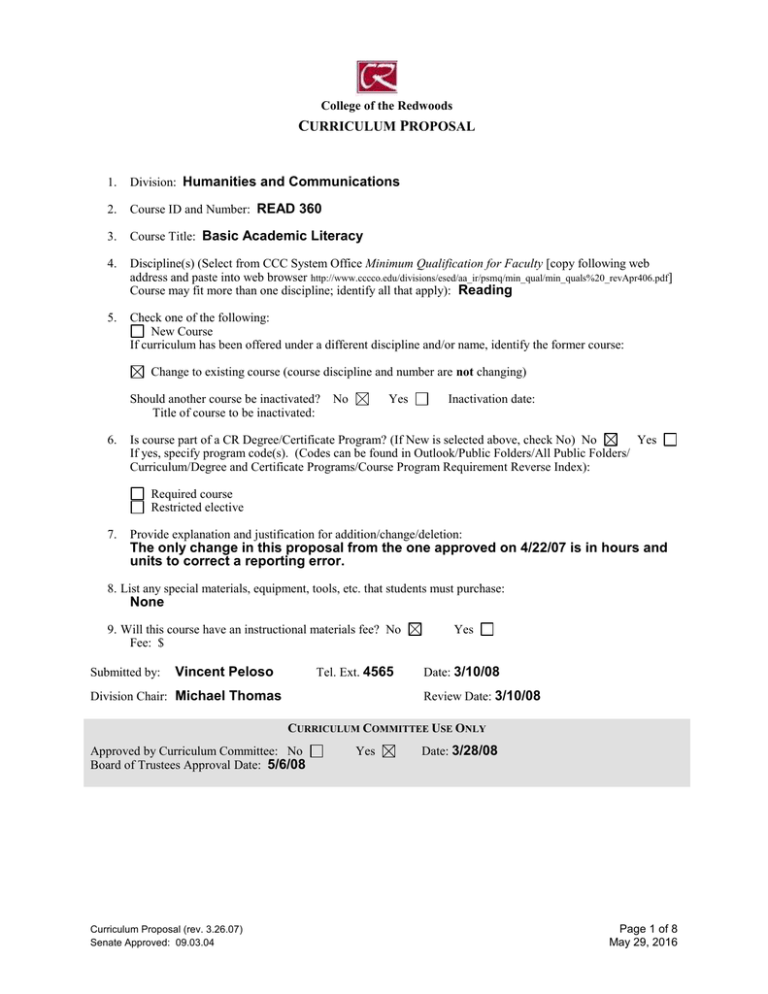
College of the Redwoods CURRICULUM PROPOSAL 1. Division: Humanities and Communications 2. Course ID and Number: READ 360 3. Course Title: Basic Academic Literacy 4. Discipline(s) (Select from CCC System Office Minimum Qualification for Faculty [copy following web address and paste into web browser http://www.cccco.edu/divisions/esed/aa_ir/psmq/min_qual/min_quals%20_revApr406.pdf] Course may fit more than one discipline; identify all that apply): Reading 5. Check one of the following: New Course If curriculum has been offered under a different discipline and/or name, identify the former course: Change to existing course (course discipline and number are not changing) Should another course be inactivated? Title of course to be inactivated: 6. No Yes Inactivation date: Is course part of a CR Degree/Certificate Program? (If New is selected above, check No) No Yes If yes, specify program code(s). (Codes can be found in Outlook/Public Folders/All Public Folders/ Curriculum/Degree and Certificate Programs/Course Program Requirement Reverse Index): Required course Restricted elective 7. Provide explanation and justification for addition/change/deletion: The only change in this proposal from the one approved on 4/22/07 is in hours and units to correct a reporting error. 8. List any special materials, equipment, tools, etc. that students must purchase: None 9. Will this course have an instructional materials fee? No Fee: $ Submitted by: Vincent Peloso Tel. Ext. 4565 Division Chair: Michael Thomas Yes Date: 3/10/08 Review Date: 3/10/08 CURRICULUM COMMITTEE USE ONLY Approved by Curriculum Committee: No Board of Trustees Approval Date: 5/6/08 Curriculum Proposal (rev. 3.26.07) Senate Approved: 09.03.04 Yes Date: 3/28/08 Page 1 of 8 May 29, 2016 SUMMARY OF CURRICULUM CHANGES FOR AN EXISTING COURSE FEATURES Catalog Description OLD NEW (Please include complete text of old and new catalog descriptions.) Grading Standard Select Select Lecture Units 3 5 Lab Units 3 1 Total Units Prerequisites Corequisites Recommended Preparation Maximum Class Size Repeatability— Maximum Enrollments Other If any of the listed features have been modified in the new proposal, indicate the “old” (current) information and proposed changes. Curriculum Proposal (rev. 3.26.07) Senate Approved: 09.03.04 Page 2 of 8 May 29, 2016 College of the Redwoods COURSE OUTLINE DATE: 3/10/08 COURSE ID AND NUMBER: READ 360 COURSE TITLE: Basic Academic Literacy FIRST TERM NEW OR REVISED COURSE MAY BE OFFERED: Fall 2008 TOTAL UNITS: 6 TOTAL HOURS: 144 [Lecture Units: 5 [Lecture Hours: 90 Lab Units: 1] Lab Hours: 54] MAXIMUM CLASS SIZE: 20 GRADING STANDARD Letter Grade Only CR/NC Only Is this course repeatable for additional credit units: No Grade-CR/NC Option Yes If yes, how many total enrollments? Is this course to be offered as part of the Honors Program? No Yes If yes, explain how honors sections of the course are different from standard sections. CATALOG DESCRIPTION The catalog description should clearly state the scope of the course, its level, and what kinds of student goals the course is designed to fulfill. A course designed to focus on the basic reading and writing skills for those students whose placement scores indicate a need for additional preparation before moving into the developmental English sequence. Special notes or advisories: PREREQUISITES No Yes Course(s): Rationale for Prerequisite: Describe representative skills without which the student would be highly unlikely to succeed . COREQUISITES No Yes Rationale for Corequisite: Curriculum Proposal (rev. 3.26.07) Senate Approved: 09.03.04 Course(s): Page 3 of 8 May 29, 2016 RECOMMENDED PREPARATION No Yes Course(s): Recommended co-enrollment in GS 361 (Basic Skills for Life, Work, and College) Rationale for Recommended Preparation: This course and GS 361 create a full-time package of courses to prepare students to begin the developmental curriculum at College of the Redwoods. COURSE LEARNING OUTCOMES What should the student be able to do as a result of taking this course? State some of the objectives in terms of specific, measurable student accomplishments. 1. Demonstrate an increased vocabulary. 2. Demonstrate an increased level of reading comprehension. 3. Identify and summarize the main idea in a paragraph. 4. Organize supporting details. 5. Draw simple inferences. 6. Differentiate fact from opinion. 7. Identify and manipulate parts of speech. 8. Identify and coordinate subjects and verbs. 9. Write grammatically correct and expressive simple, compound, and complex sentences. 10. Construct and write a variety of simple, grammatically correct paragraphs. 11. Demonstrate the ability to preview a variety of texts, locating main ideas and pinpointing specific information. 12. Take clear and useful notes on lectures and textbooks. 13. Model basic familiarity with the fundamentals of computers as they assist reading and writing. Note: This class will culminate in a standardized reading comprehension exam (DRP) and a holistically graded writing exam using the English Department's approved rubric to determine whether students have demonstrated the necessary skills to enter English 350. COURSE CONTENT Themes: What themes, if any, are threaded throughout the learning experiences in this course? Concepts: What concepts do students need to understand to demonstrate course outcomes? 1. Reading comprehension. 2. Fluency. 3. Active reading strategies. 4. Effective composition strategies. 5. Paragraph organization and construction. 6. Grammatical standards and structures. 7. Sentence styles and functions. 8. Main idea identification. 9. General/specific differentiation. 10. Evidence and argument evaluation. Curriculum Proposal (rev. 3.26.07) Senate Approved: 09.03.04 Page 4 of 8 May 29, 2016 Issues: What primary issues or problems, if any, must students understand to achieve course outcomes (including such issues as gender, diversity, multi-culturalism, and class)? 1. Opinion/fact differentiation. 2. Valid argumentation. 3. Diversity of views. 4. Logical linguistic structures. Skills: What skills must students master to demonstrate course outcomes? 1. Read with comprehension (at a level for entry into English 350). 2. Demonstrate a variety of word attack skills. 3. Demonstrate accurate and expressive reading fluency. 4. Use a variety of active reading strategies to achieve comprehension. 5. Generate a variety of well developed paragraphs. 6. Develop an effective study system. 7. Adopt an effective note-taking system. 8. Develop an effective composition strategy. 9. Participate in class activities and discussions. 10. Demonstrate an appreciation for diverse viewpoints, arguments, and opinions. REPRESENTATIVE LEARNING ACTIVITIES What will students be doing (e.g., listening to lectures, participating in discussions and/or group activities, attending a field trip)? Relate the activities directly to the Course Learning Outcomes. 1. 2. 3. 4. 5. 6. 7. Actively listen to lectures. Take notes in class. Develop an effective prewriting, composing, and revising process. Utilize a variety of appropriate active reading strategies Practice oral reading to improve fluency. Utilize a variety of effective word attack strategies. Contribute to class discussions and activities. ASSESSMENT TASKS How will students show evidence of achieving the Course Learning Outcomes? Indicate which assessments (if any) are required for all sections. Representative assessment tasks: 1. 2. 3. 4. 5. Quizzes. Exams. Portfolio Review (Reading and paragraph assignments). Instructor Performance Review. Participation/Presentation. Required assessments for all sections – to include but not limited to: 1. DRP (Degrees of Reading Power) Standardized Reading Comprehension Exam. 2. Competency Writing Exam (holistically graded by approved English Dept. rubric). EXAMPLES OF APPROPRIATE TEXTS OR OTHER READINGS Author, Title, and Date Fields are required Author Broderick, Author Johnson, Author Title Bill Title Groundwork for College Reading Mohn, Goldstein Title Date 2008 Groundwork for a Better Vocabulary Date 2004 Date Curriculum Proposal (rev. 3.26.07) Senate Approved: 09.03.04 Page 5 of 8 May 29, 2016 PROPOSED TRANSFERABILITY: CSU UC If CSU transferability is proposed (courses numbered 1-99), indicate whether general elective credit or specific course equivalent credit is proposed. If specific course equivalent credit is proposed, give course numbers/ titles of at least two comparable lower division courses from a UC, CSU, or equivalent institution. None General elective credit Specific course equivalent 1. , (Campus) 2. , (Campus) CURRENTLY APPROVED GENERAL EDUCATION CR CSU IGETC CR GE Category: CSU GE Category: IGETC Category: PROPOSED CR GENERAL EDUCATION Rationale for CR General Education approval (including category designation): Natural Science Social Science Humanities Language and Rationality Writing Oral Communications Analytical Thinking PROPOSED CSU GENERAL EDUCATION BREADTH (CSU GE) A. Communications and Critical Thinking A1 – Oral Communication A2 – Written Communication A3 – Critical Thinking C. Arts, Literature, Philosophy, and Foreign Language C1 – Arts (Art, Dance, Music, Theater) C2 – Humanities (Literature, Philosophy, Foreign Language) E. Lifelong Understanding and SelfDevelopment E1 – Lifelong Understanding E2 – Self-Development B. Science and Math B1 – Physical Science B2 – Life Science B3 – Laboratory Activity B4 – Mathematics/Quantitative Reasoning D. Social, Political, and Economic Institutions D0 – Sociology and Criminology D1 – Anthropology and Archeology D2 – Economics D3 – Ethnic Studies D5 – Geography D6 – History D7 – Interdisciplinary Social or Behavioral Science D8 – Political Science, Government and Legal Institutions D9 – Psychology Rationale for inclusion in this General Education category: Same as above Curriculum Proposal (rev. 3.26.07) Senate Approved: 09.03.04 Page 6 of 8 May 29, 2016 Proposed Intersegmental General Education Transfer Curriculum (IGETC) 1A – English Composition 1B – Critical Thinking-English Composition 1C – Oral Communication (CSU requirement only) 2A – Math 3A – Arts 3B – Humanities 4A – Anthropology and Archaeology 4B – Economics 4E – Geography 4F – History 4G – Interdisciplinary, Social & Behavioral Sciences 4H – Political Science, Government & Legal Institutions 4I – Psychology 4J – Sociology & Criminology 5A – Physical Science 5B – Biological Science 6A – Languages Other Than English Rationale for inclusion in this General Education category: Curriculum Proposal (rev. 3.26.07) Senate Approved: 09.03.04 Same as above Page 7 of 8 May 29, 2016 FOR VPAA USE ONLY PROGRAM AND COURSE NUMBER READ-360 TECHNICAL INFORMATION 1. Department: COMM Communications 16. CoRequisite Course: None 2. Subject: Reading 17. Recommended Prep: Co-enrollment GS-361 Course No: 360 3. Credit Type: C Credit Not Degree Applicable 18. Maximum Class Size: 20 4. Min/Maximum Units: 6.0 to 19. Repeat/Retake: R1 May enroll 2 times for credit variable units 5. Course Level: E Not Occupational 20. Count Retakes for Credit: yes no 6. Academic Level: UG Undergraduate 21. Only Pass/No Pass: yes no 7. Grade Scheme: UG Undergraduate 22. Allow Pass/No Pass: yes no 8. Short Title: Basic Academic Literacy 23. VATEA Funded Course: yes no 9. Long Title: Basic Academic Literacy 24. Accounting Method: X Not Reported 10. National ID 11. Local ID (CIP): (TOPS): 32.0108 493070 12. Course Types: Level One Basic Skills: P Precoll Basic Skills Level Two Work Experience: 25. Disability Status: N Not a Special Class 26. Billing Method: T-Term 27. Billing Period: R-Reporting Term 28. Billing Credits: 6.0 29. Purpose: B Developmental Preparatory NWE Not Coop Work Experience 30. Articulation No. Level Three: (CAN): Placeholder for GE OR 31. Articulation Seq. (CAN): DOES NOT APPLY 32. Transfer Status: C Not transferable Level Four: If GE : Choose One: 33. Equates to another course? (course number). 13. Instructional Method: LL Lecture/Lab 14. Lec TLUs: 7.5 Contact Hours: 90 Lab TLUs: 3.0 Contact Hours: 54 Lecture/Lab TLUs: 10.5 Contact Hours: 144 34. The addition of this course will inactive GS-360 (course number). Inactive at end of Spring 2007 term. 15. Prerequisite: None Particular Comments for Printed Catalog. . Curriculum Approval Date: 3/28/08 Curriculum Proposal (rev. 3.26.07) Senate Approved: 09.03.04 Page 8 of 8 May 29, 2016
